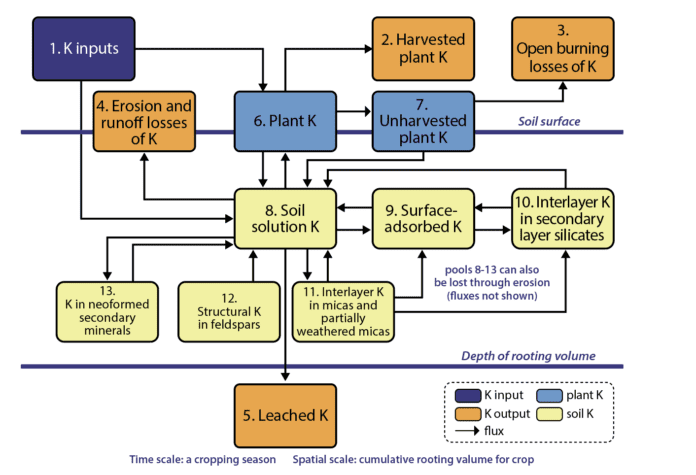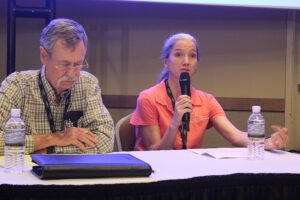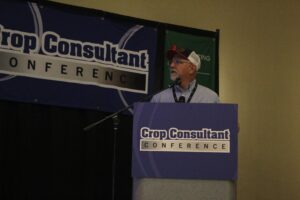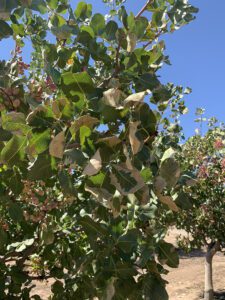
Potassium plays a crucial role in the essential plant processes of perennial crops, helping crops like tree nuts to regulate water uptake and usage, enhance photosynthesis and improve nutrient transportation. It’s also particularly important for kernel development, quality and yield.
A panel discussion at September’s Crop Consultant Conference in Visalia, Calif. focused on a variety of potassium-related issues. Moderator Stephen Vasquez, executive director of Administrative Committee for Pistachios and a CCA, said it’s important to consider the short- and long-term impacts of fertilizer decisions regarding potassium to maximize applications, since potassium, like many other fertilizers, isn’t cheap. He said meeting with your agronomy team, employees, farm advisor and CCA to review lab results and identify solutions, whether through products or different strategies, to improve potassium applications are all things to keep in mind, as well as the four Rs (right product, right rate, right time and right place).
Soil Health and Potassium Availability
Panelists were asked how they would describe poor or unhealthy soil when it comes to potassium availability. Fresno County UCCE Nuts Crop Farm Advisor Mae Culumber, who primarily works with almond, pistachio and walnut, explained unhealthy soil is soil that is unable to support plant growth and productivity due to factors like nutrient deficiencies, such as low potassium. She also noted compacted soil and low organic matter further hinder root growth and nutrient movement, reducing plant health and yields.
“Something else is the exchange capacity of the soil, and then if the soils have a tendency to fix potassium,” she said. “So those would be the characteristics that would constitute a poor or unhealthy soil.”
Paul Giboney, ranch agronomist with Hronis Inc., noted in addition to soil issues like poor moisture availability and poor preparation for planting, there might also be soil pests, which make fumigation important. He added fixation, which makes nutrients less available to the crop, is also important to consider.
When unhealthy soil struggles to supply adequate potassium to plants, even if it contains sufficient amounts of the nutrients, the structure of the soil plays a critical role as potassium moves through the soil via diffusion, according to Ehsan Toosi, director of research and development for True Organic Products.
He explained if the soil is compacted or has poor pore connectivity, potassium may be trapped and unable to reach plant roots, which limits its effectiveness despite being present in the soil, so addressing soil structure is essential to ensure proper nutrient movement and availability for healthy plant growth.
“Another example is when you have, and this is a chemical attribute, when you have sodium, which competes with potassium in terms of plant uptake, or soil that is poor in organic matter, so they cannot retain or capture potassium, so you have a lot of losses,” Toosi said.

Excess Potassium
Overabundance of potassium can also present challenges, noted Vasquez, who asked panelists to discuss the implications of managing soil with excessive potassium levels.
Culumber explained that although soil may contain high levels of potassium, the amount available to plants depends on its soluble and exchangeable forms. She said soils derived from the Sierra can have high potassium content due to their mineral composition, but it weathers very slowly, so while a lab may tell you there’s an abundance of potassium, it’s not necessarily in an available form.
“But if you’re talking about what you would see in a soil test in terms of exchangeable potassium, I know it varies with different crops, but probably if you’re somewhere above 100 to 150 parts per million, that would be considered abundant,” Culumber said.
Growers should ask themselves in terms of their annual crop requirement how much is needed for growth, whether the pool meets the requirement, and if it can be replenished with their annual application, she added.
Giboney noted the importance of timing in meeting plant nutrient needs, pointing out the rate at which soil releases potassium may not align with the plant’s demand, so even if a soil test shows high potassium levels, the plant could still experience deficiencies if the nutrient is not released quickly enough to meet its growth stages.
Other things to consider, he said, would be the state of availability of other cations that might compete with potassium, or their availability might be impacted by potassium.
“And oftentimes you can have soils with a lot of potassium and have a reduced infiltration rate, so that would need to be managed, perhaps through applications of gypsum or compost or both,” Giboney said.

Soil and Tissue Analysis
When looking at the various analysis methods for determining potassium needs in plants, each has its specific applications, advantages and limitations. Toosi explained while soil and tissue tests can provide a good picture of a plant’s potassium status when done correctly, more advanced methods like SAP analysis may not be practical for routine use because they can be too invasive or too costly for regular testing.
“I would say soil and tissue still are adequate enough as long as we follow the protocols,” he said.
While Giboney agreed those were good tools, he said he wouldn’t hang his hat on them.
“In addition to using those and following those measurements over time would be in-field observations and determining the amount of potassium that’s being recommended, enough to replace what’s being utilized by the crop,” Giboney said. “Research by Conradie suggests we could put on 16% of potassium needed by grapevines before bloom.”
Culumber said it’s important to understand soil characteristics like cation exchange capacity (CEC) and texture when managing potassium applications. For heavy clay soils with high CEC, a single postharvest application might be enough to meet potassium needs for the year, but sandy soils or those prone to potassium fixation might require smaller, more frequent applications. In almond and pistachio, she explained, tissue analysis thresholds around 1.6% are useful for postharvest application guidance. If tissue potassium levels exceed 1.8%, that won’t necessarily increase your yield, and it could lead to calcium or magnesium deficiencies.
“I actually saw that in the field this week where soil analysis was 400 parts per million of exchangeable K, and they had severe magnesium deficiency,” she said.

Timing, Applications and Amendments
The panel highlighted the importance of multiple smaller applications for sandy or potassium-fixing soils and explored the use of foliar applications as a supplement during critical growth stages. Giboney said there are several products available for potassium issues that need to be addressed.
“In my experience, especially when we’re trying to do a little bit of correction and some maintenance, we might use potassium sulfate banded down a drip row, blended with green waste compost and maybe some gypsum,” he said, noting it should be done as close to the start of the season as possible to give the soil less time to fix the potassium.
He added it’s an approach from several different angles rather than just one simple product.
Regarding timing, Culumber noted uptake in pistachio specifically will be better when the leaves are newly developing, but signs of possible deficiency may show up later in the season.
Vasquez noted an experience he had working with a grower to correct a variety of issues that ultimately came down to using a combination of products paired with right timing.
“I don’t know how he’s doing this year but, timing is everything, and then availability, and making sure you have the right combination of products I think is very important,” he said.
The panelists also addressed the use of organic amendments, such as compost and green waste, to enhance potassium availability by improving soil structure and moisture retention. Toosi suggested if your budget and operation allow for it, 25% to 30% of your key nutrients could come from green waste, composted manure or pelletized fertilizers.
“And the reason is that, No. 1, you raise nutrient use efficacy, but also you bring carbon to the system, you bring different forms of nutrients,” he said, “That’s not true for potassium because it’s always K+, unlike plus, but like nitrogen or phosphorus, you bring organic forms which are slow release… you basically put them through the biological loop, which is consistent with the concept of soil health.”
But Giboney warned certain amendments (e.g., animal manures) may introduce things you don’t want to add to the soil, such as unwanted salts.
“So that could be something to be cautious of,” he said.

Kristin Platts | Digital Content Editor and Social Correspondence
Kristin Platts is a multimedia journalist and digital content writer with a B.A. in Creative Media from California State University, Stanislaus. She produces stories on California agriculture through video, podcasts, and digital articles, and provides in-depth reporting on tree nuts, pest management, and crop production for West Coast Nut magazine. Based in Modesto, California, Kristin is passionate about sharing field-driven insights and connecting growers with trusted information.















